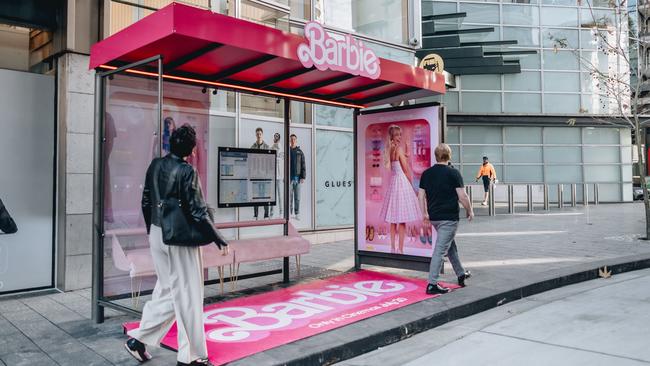How brand Barbie is reinventing itself
New research from brand tracking firm Tracksuit has measured consumer affinity with Barbie ahead of the film’s release this week. Here’s how the brand is making its mark outside of the toy aisle.

In case you haven’t heard, Barbie: The Movie will be released this week. But Barbie’s unmistakeable pink-clad brand has been travelling prolifically outside cinemas over the past month.
To mark the occasion, there are pink bus shelters. There are pink holiday rental properties. There are even pink hamburgers.
The brand has embarked on a massive marketing push for relevance, many of which include brand collaborations, however new research from brand tracking start-up Tracksuit shows some consumer attitudes towards brand Barbie are split, compared to other toy brands.
Tracksuit’s report found that only 49 per cent of consumers consider Barbie a brand they currently “relate” to. This is comparably low to other brands that have also entered the movie-making market, with Lego at 75 per cent and Hot Wheels, 66 per cent.
Tracksuit also asked respondents to share how emotionally connected to brand Barbie they feel.
More than 52 per cent of Australians claim Barbie is a brand they “love”. In comparison, 67 per cent “love” Hot Wheels, and 82 per cent feel the same way about Lego.
Additionally, 75 per cent of Australians feel that Barbie is a “unique” brand, compared to 87 per cent who feel that way about Lego.
According to Tracksuit, Barbie brand awareness in Australia is the strongest among audiences aged 55 and over at 91 per cent. Seventy two per cent of 18-34 year olds and 76 per cent of 35-54 year olds are aware of the brand.
But can Barbie: The Movie, its all-star cast, evolving empowered “narrative” and the marketing surrounding it move the needle on these attitudes – and ultimately drive both short and long-term commercial results for the brand?
“With all the marketing that we are seeing, I think Barbie is regaining relevance,” Tracksuit head of marketing Mikayla Hopkins told The Growth Agenda.
“They are targeting so broadly, and we‘ve never seen them do it in this way before. They’re elevating the Barbie narrative into a pop culture sensation,” Ms Hopkins said.
Barbie’s evolving “narrative” could prove a powerful one to drive relevance with audiences, and in recent years it has made attempts to be more representative of the audience it serves.
Ms Hopkins said: “(Barbie) tried to open up conversations around diversity and inclusion, and they have brought out new ranges of dolls that paint a different picture of what it means to be a woman. And I think that‘s been really important.
“But I also feel like they’ve almost skirted around the fringe of what that could be. But now with this, I think it’s at scale. That changing narrative is coming into mainstream conversation.”

The real power of the brand, Ms Hopkins added, is how Barbie is leveraging its identity outside of the toy aisle to drive relevance.
Ms Hopkins said the brand is using this cultural moment to reach a new pool of potential customers.
“They’re (also) tapping into the existing demand. And they’re doing that by really flexing that nostalgia muscle with all the people who grew up with Barbie and loved her growing up,” Ms Hopkins said.
Outside of toys, fashion-led products, such as accessories brand Fossil’s series of Barbie-branded timepieces, are among the more expected collaborators given Barbie’s 60-year-old sartorial reputation, however the canvas for commercially-driven creativity is wider.
In the US, Airbnb listed a pink-clad DreamHouse in Malibu, California, while in Australia, burger chain Grill’d launched a “Barbie Dreamburger Bundle”. Yes, even burgers can be relevant to brand Barbie. And yes, the hamburger is also pink.
Chief marketing officer at Grill’d, Ben Goss said: “We’ve always been a progressive and inclusive brand that welcomes all tribes to our table, so it was an absolute no-brainer to get involved with a film that aligns so clearly with these values.”
A Sydney bus shelter has also been given the Barbie creative treatment, complete with bold pink branding and seats, which will stay in place until the end of July.

It comes from out-of-home media company JCDecaux Australia in partnership with Universal Pictures Australia on behalf of Warner Bros. and media agency Essence Mediacom.
Chief commercial officer at JCDecaux Australia, Max Eburne said the out-of-home environment is still particularly popular for film advertisers for its mass and rapid reach. But he thinks the creativity that has made this ad placement stand out.
“For Barbie in particular, the fact that it is such a compelling visual, creative, ‘pink’, brand proposition, particularly in the winter months in Australia, the creative has absolutely popped.”
Mr Eburne said investing in creative execution appears to be part of the film’s “high impact strategy” when it comes to advertising.
“They probably use the media channel for its core attributes that lots of other film advertisers do,” added Mr Eburne. “But it does feel like they‘ve taken a slightly different kind of strategy with an element of creativity behind it, to play on the diverse nature of different Barbies.”
Ms Hopkins said that while marketers must work to convert existing demand into sales, and build brands for “future demand”, Barbie: The Movie and the massive marketing efforts surrounding it may further cement the growth-driving role of marketing within businesses.
“If (Barbie) are going this wide with their marketing, and are potentially resonating with a group of people that are 80-90 per cent out of the market, that could change everything for the brand … proving the impact of how you make a brand culturally relevant and what that actually does at a commercial level.”
“What will be interesting is when the movie is actually released, how that legacy brand of only showing one type of woman and the storytelling around that how that then changes – and emotionally relates to a much wider pool of people.”







